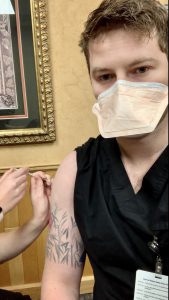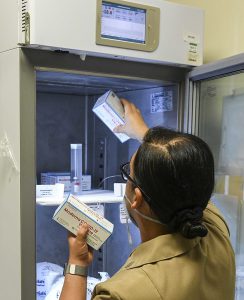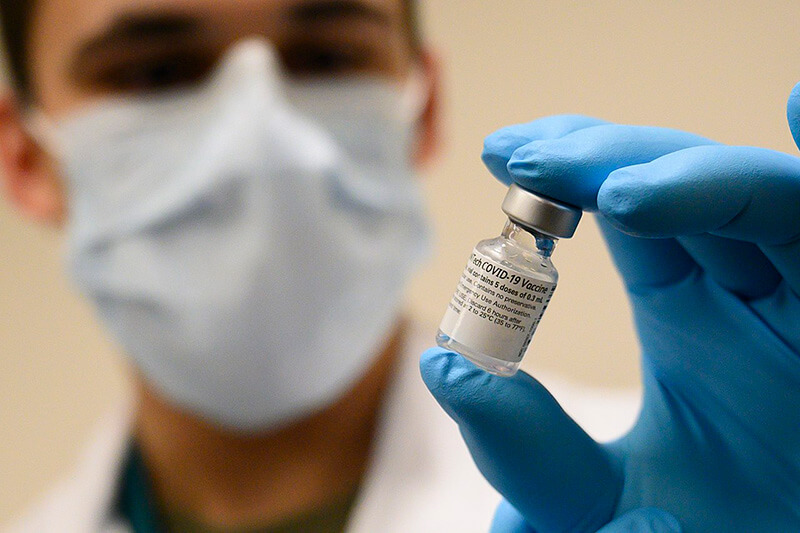There are more than 120,000 medical students in the United States.
Like most others studying medicine around the world, they have their med school experience transformed like few generations before, in the last year.
The COVID-19 global pandemic has scrambled student bodies and faculties alike. While long term trends are uncertain, short term ‘Zoomified’ alternatives will surely linger, creating new problems, and solutions, in the study of medicine.
Yet despite sharing virtually all the same learning disruptions COVID-19 has forced, American med students have already had wildly different experiences when it comes to receiving—or administering—the vaccine for it.
Different states have prioritized med students in residencies or at clinical sites in higher groups, while others, including those studying dentistry, have seen far more uncertainty.
I think we are a population that is usually willing to serve in any way possible. If we were trained, we’d definitely be a group of people that could provide those services.
Communication of vaccination plans from faculty have been far from uniform, while one prestigious med school used a controversial ‘reverse alphabetical’ student vaccine rollout.
Beyond receiving their shots, and being able to continue with their study of medicine, the potential of utilizing med students in what will be the largest vaccination drive in the American history is obvious.
Like in the United Kingdom, some states have been accepting med students as volunteers to administer vaccines for almost a month. Others are relaxing regulations, so they can too.
“I think we are a population that is usually willing to serve in any way possible,” Logan Lawson, a third-year student at the Philadelphia College of Osteopathic Medicine, says.
“If we were trained, we’d definitely be a group of people that could provide those services.”
A place in the vaccine queue
Currently on a clinical rotation in Reading, Pennsylvania, Lawson received her first COVID-19 vaccine shot recently.
Amongst the 17.2 million COVID-19 vaccine doses that have been administered in the U.S over the last five weeks, it is virtually impossible to know how many have gone into med students’ arms.
Given their proximity to patients, residents, and those on clinical rotations, stand a far greater chance of having been vaccinated, while those in their early years of study may be waiting the summer, like others in their age group.
“I was treated like any of the residents or attending doctors, which I’m very, very grateful for,” Alex Campbell, a third-year studying at the New York Institute of Technology College of Medicine’s satellite campus in Jonesboro, Arkansas, says.

Currently on a clinical rotation at Medical Center of Southern Arkansas in El Dorado, Arkansas, Campbell has received his first Pfizer shot in early January. The 27-year-old spends time in the hospital’s COVID-19 intensive care unit (ICU), regularly.
“It is important to realize that we are students now, and are learning, at least on my end, I have to go to the COVID ICU all the time,” he says.
“I’m [as] exposed as anyone else. Even though I might not be the one making all the decisions about patient wellbeing, I would still be a vector for transmission – and cutting down on transmission is so important in the hospital, and protecting the people who should be working.”
Med students were included as a group to be prioritized in guidelines set by the Centers for Disease Control and Prevention (CDC), following the emergency approval of the Pfizer and Moderna COVID-19 vaccinations in December.
Despite the federally recommended suggestions, states themselves control the valves on who received their dosage supply first.
Written by Emma Goldberg, a well-reported New York Times story recently revealed some med schools, such as Duke School of Medicine, have included all students working in ICUs and emergency departments as “the highest level priority group, 1A”, while others fell into 1B.
Yale School of Medicine went a different route, announcing the student body rollout would proceed in reverse alphabetical order, for surnames.
“Those who were at the later stages of the alphabet were happy, but a bit confused as to how arbitrary it was,” Sumun Khetpal, a fourth-year student, said.
Some schools, like Tufts University in Boston, have included third and fourth year dental students in early vaccinations, though there is evidence that dental students elsewhere have fallen further down the list.
The CDC guidelines did not have the level of granularity needed for hospitals and schools to make decisions.
Complicated by the pressure of other learning disruptions, the necessity of an uneven vaccine rollout amongst students, and the wider problems with state administration plans, communication from faculty on vaccinations has sometimes been patchy.
Goldberg reported that students at some med schools in Texas and Pennsylvania have been kept in the dark for weeks, leading some to seek private pharmacy options.
“The CDC guidelines did not have the level of granularity needed for hospitals and schools to make decisions,” Dr. Alison Whelan, chief academic officer of the Association of American Medical Colleges (AAMC), told the Times.
Published in the Oxford Academic on December 26, a study of around 400 U.S med students showed that—despite overwhelmingly positive attitudes towards vaccines—nearly a quarter were “unwilling to take a COVID-19 vaccine immediately upon FDA approval.”
While the sample size is small, it does correspond with vaccine reticence in healthcare workers, up to 29 per cent, according to one recent study.
Opportunities to help
After the first vaccinations took place in December, several states sought to include med students in the COVID-19 vaccination program.
On December 13, New York preemptively loosen regulations to allow medical, nursing, pharmacy, dentistry, podiatric, and midwifery students to administer shots, while under supervision, while Massachusetts has also made changes. They match similar actions in the U.K.
According to Reuters, at least seven state health departments were looking for volunteers by December 24, “some partnering with local universities or nursing schools to offer incentives such as tuition discounts and hands-on training.”
Some schools have really stood up. The University of Wisconsin is offering $500 tuition credits to medical students working at “understaffed hospitals” over the winter, many of whom have had to administer vaccinations, Reuters says. UW facilities have also been utilized to create mass vaccination centers.
The University of Alabama at Birmingham (UAB) usually has nursing students help with yearly flu vaccine drives, but this winter, they’ve included medical and dental students in the COVID-19 effort.
A recent CNN story reported that public health students have also been recruited; not to administer doses – but to help run vaccination centers.
“There’s a lot of logistics involved when you have a vaccine site that processes over 1000 people a day, so it’s truly been a community effort here on campus,” Dr. Sarah Nafizger, professor of emergency medicine at UAB, told CNN. “It’s been a beautiful thing to watch.”
As Lawson indicated, the enthusiasm from the majority of the med student population to play their part in American public health history has really shone through.

“Within the first days [in December], we saw some ten schools develop plans for students to assist with vaccination, and we expect more to follow,” Katherine McOwen, the AAMC senior director of education affairs, said.
Outside the hands-on work, there’s another important way med students can impact the COVID-19 vaccine rollout. Recently, Brit Trogen, a pediatrics resident at Bellevue Hospital and NYU Langone in New York, wrote in The Atlantic about the trend of young healthcare workers sharing social media shots of getting a vaccination themselves.
“The vaccine selfie may seem like a relatively modest endeavor in the public-health effort against COVID-19,” Trogen wrote, “but together the people posting these early images share a formidable message: We believe in this so strongly, we’re not only volunteering to go first, but are thrilled to be given the chance.”
Campbell agrees. “Showing that so many of us are willing to get this vaccine and share our experiences, and help with the vaccine hesitancy,” he says.
“Not like the devout anti-vaccine community, I don’t think we’re going to change [their minds], but the people who are just worried about a different timeline, the lack of clarity or the fact that we finished this in seven months.
“Having a more personal, emotional story I think is going to help people relate to that. That is an excellent way for med students being involved.”
With President Joe Biden setting a target of 100 million Americans vaccinated against COVID-19 in his first 100 days of office amongst an initially tricky rollout, every little contribution counts.
Campbell says that so too is the importance of knowing med students aren’t alone in dealing with the immensity of this whole experience.
The vaccine selfie may seem like a relatively modest endeavor in the public-health effort against COVID-19, but together the people posting these early images share a formidable message: We believe in this so strongly, we’re not only volunteering to go first, but are thrilled to be given the chance.
“Every step forward is going to eventually make you a doctor,” he says. “Even if you’re still studying the books, we can’t sacrifice that generation of med students. Don’t feel like you’re not doing enough right now.
“To the peers I have out in the field: we’ll get through it. When you feel really alone, just know that there are lots of other people feeling the same way – and they shouldn’t be afraid to reach out.”



